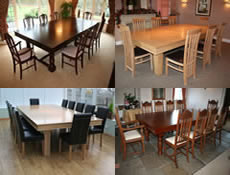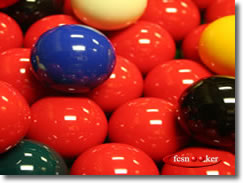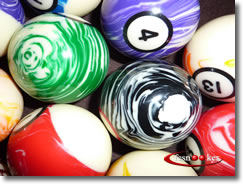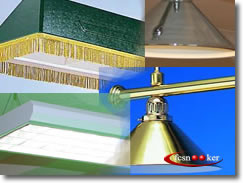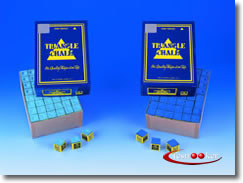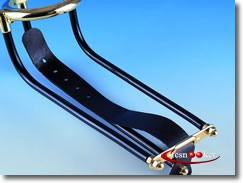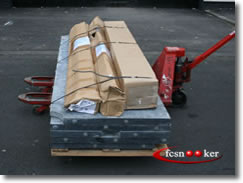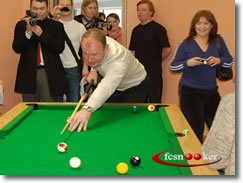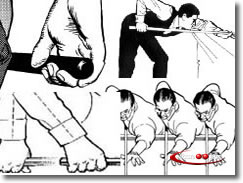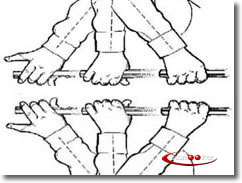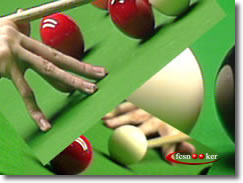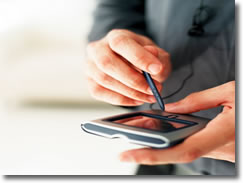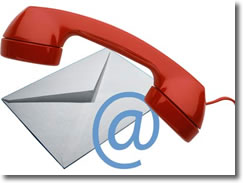 |
|||||||
 |
|||||||
Welcome
to www.fcsnooker.co.uk - United Kingdom
suppliers of Snooker Tables, Billiard
Dining Tables, English Pool Dining
Tables, English Pool Tables and American
Pool Tables |
|||||||
|
Billiards was the original forerunner to snooker and for many years was deemed to be the more sophisticated of the two games. Unfortunately the players of the early twentieth century, Joe Davis, Walter Lindrum and others had become so good at the game that they had killed it as a form of public entertainment. Due to their complete mastery of the game, breaks of a thousand plus became common at the very top level, removing the excitment and tension of matches with less perfect players on view. The professional game soon bore little resemblance to the game played by amateurs and juniors at club level and slowly started to diminish in popularity. At this time, snooker became more readily accessible for the general public to enjoy and this increased competition signalled if not the end, close to it for billiards. This was unfortunate, as to play billiards successully requires great touch, feel and excellent hand to eye co-ordination. The basic principles of snooker - straight cueing, solid stance, firmness of bridge and clarity of thought and mental approach, all apply for billiards. These basics must be mastered to become a decent player. Failure to do so results in a haphazard approach and style of play which leads nowhere and which ultimately affects a players enjoyment of the game. It is strongly recommended that you try and learn the basic prinicples of billiards. This will assist your learning curve on cue ball control and the vagaries of spin and will introduce you to the many different angles available on the snooker and billiards table. The Game English Billiards is played by two persons or sides and is best summarised as follows: a) Three balls are used: a plain white by one player and a spot white used by the other player, plus one red. b) Scoring strokes in a players turn are made by pots, in-offs and cannons played singly or in combination. c) Points awarded for scoring strokes are added to the score of the striker. d) Penalty points from fouls and misses are added to the opponents score. e) A useful tactic which can be employed at any time during a game is to leave both object balls in Baulk, when the next player is in-hand, such that any attempt to disturb the balls must be made by means of an indirect stroke. f) The winner of the game is the player or side: i)
who has scored most points in the agreed or stipulated time g) The winner of the match is the player or side winning most games, or where aggregate points are relevant, with the greatest total. Definitions Game A game is the period of play from the opening stroke until it is completed by; Reaching the end of a specified time period - By either side reaching the number of points specified - The game being awarded by the referee under Section Four - Rule Two (Unfair Conduct) Match A match is an agreed or stipulated number of frames. Balls The cue-ball is the ball of the striker - The other white and the red are the object balls. Striker The person about to play or in play is the striker and remains so until the referee has decided he has left the table at the end of his turn. Stroke A stroke is made when the striker strikes the cue ball with the tip of the cue - A stroke is fair when no infringement of the rules is made - A stroke is not completed until all balls have come to rest - A stroke may be made directly or indirectly, thus, a stroke is direct when the cue-ball strikes an object ball without first striking a cushion. a stroke is classed as indirect when the cue-ball strikes one or more cushions before striking the first, or second object ball. Pot A pot is when an object ball, afetr contact with another ball and without any infringement of the rules, enters a pocket. Causing a ball to be potted is known as potting. A pot is also known as a winnign hazard. In-Off An in-off is when the cue-all, after contacting an object ball and without any infringement of the rules, enters a pocket. If both object balls are contacted by the cue-ball, it is helf that the ball went in-off the first object ball contacted. An in-off is also known as a losing hazard. Hazard A hazard is any scoring stroke that does not include a cannon, being any of; a pot an in-off two pots a pot and an in-off two pots and an in-off Cannon A cannon is when, without any infringement of the rules the cue-ball makes contact with both object balls during a stroke. Break A break is a number of scoring strokes in succession made in any one turn by the striker. In-Hand A players ball is in-hand; before the start of each game when it has entered a pocket when it has been forced off the table It remains in-hand until; it is played fairly from in-hand a foul is committed whilst the ball is on the table it is spotted after being forced off the table Ball in Play A players ball is in play when it is not in-hand The red is in play when spotted and remains so until pocketed or forced off the table Ball in Baulk A ball is in baulk when it rests on the baulk line or that line and the bottom cushion. Forced off the Table A ball is forced off the table if it comes to rest other than on the bed of the table or in a pocket, or if it is picked up by the striker whilst it is in play Miss A miss is when the cue ball fails to make contact with either object ball Foul A foul is any infringement of the Billiard Rules Spot Occupied A spot is said to be occupied if a ball cannot be placed on it without that ball touching another. Push Stroke A push stroke is made when the tip of the cue remains in contact with the cue ball; after the cue-ball has commenced its forward motion as the cue ball makes contact with an object ball except where the cue ball and object ball are almost touching, it shall not be deemed a push stroke if the cue-ball hits a very fine edge of the object ball Jump Shot A jump shot is made when the cue-ball passes over any part of an object ball, whether touching it in the process or not, except; when the cue-ball strikes firct strikes the one object ball and then jumps over the other ball when the cue-ball jumps and strikes an object ball, but does not land on the far side of that ball when, after striking a ball lawfully, the cue-ball jumps over that ball after hitting a cushion or another ball Fouls The following acts count as fouls: a) Striking a ball other than the cue ball b) Striking the cue ball more than once c) Striking the cue ball whne both feet are in the air d) Playing out of turn e) Playing improperly from hand f) Striking the ball before it comes to rest g) Playing a jump shot h) Playing a push shot i) Causing a ball to be forced off the table j) Making more than fifteen consecutive hazards k) Making more than seventy-five consecutive cannons l) Touching a ball or ball marker in play, other than in the lawful execution of a stroke Scoring The player who scores most points wins. Scoring is achieved as follows. Cannons A cannon is made by causing the cue ball to contact the two object balls in succession - the opponents white ball and the remaining red ball. Two points are scored from a cannon, whether it be from white to red, or red to white. In-Offs (Losing Hazards) An in-off is made by causing the cue ball to enter a pocket after contact with one of the two object balls. An in-off played off the red ball scores three points and an in-off played off the white ball scores two points. Potting A pot is made by making the cue ball contact one or other of the two object balls, causing it to enter the pocket. Potting the red ball scores three points, potting the white scores two points. Combinations When an in-off is combined with a cannon, the in-off shall score (additionally to the cannon) i) three points
if the red was struck first by the cue ball If more than one hazard or a combination of hazards and cannons are made in the same stroke, all are scored. The Officials The Referee The referee shall;
The referee shall not;
If a referee has failed to notice an incident, then they may take the evidence of the marker or other officials and spectators best placed for observation to assist his decision. The Marker The marker shall keep the score on the scoreboard and assist the referee in carrying out his duties. He shall also act as recorder if necessary. The Recorder The recrder shall maintain a record of each stroke played, showing fouls, hazards and cannons where appropriate and how many points are scored by each player or side as required. He should also take note opf break totals and calculate average scores per turn after the completion of the game. Players Rules 1.Time Wasting Should the referee consider that a player is taking too long over a shot, the selection of a shot or the game as a whole, then they will warn the player that he is liable to have the game awarded to his opponent. 2. Unfair Conduct For conduct which in the opinion of the referee is wilfully or persistently unfair, including time wasting or ungentlemanly conduct, or for refusing to continue a game, a player shall lose the game. 3. Penalty When a game is forfeited under this section: a) If it was to be decided on an agreed or stipulated number of points, the offender shall forfeit all points scored and the non-offender shall win the game by the agreed or stipulated number of points to nil, or b) If it was over an agreed or stipulated period of time and forms part of a match, the match shall be forfeited. 4. Non Striker When the striker is playing, the non-striker shall avoid moving or stnding in the line of sight of the striker. They should sit or stand at a reasonable distance from the table. 5. Absence In the case of absence from the room the non-striker may appoint a deputy to watch their interests and claim a foul if necessary. Any appointment must be made known to the referee prior to departure. 6. Conceding A player can only concede when he is the striker. The opponent has the right to accept or refuse the concession, which becomes null and void if the opponent chooses to play on. The Standard Table A slate bed, inset in a wooden framework and covered by green baize cloth, tautly drawn and having a nap running from one end to the other, forms the playing area. The table measures 12 foot by 6 foot 1 and a half inches, but the bed, being enclosed by rubber cushions which overhang it by 2 inches, is reduced for playing purposes to an area of 11 foot 8 inches by 5 foot 9 and a half inches. The table rests on eight legs, with a pocket in each corner and one placed at each side exactly in the centre, making six in total. Height The height of the table from the floor to the top of the cushion rail shall be from 2ft 9 and a half inches to 2ft 10 and a half inches (851mm to 876mm). Table Markings A line drawn 29 inches from the bottom cushion and parallel with it is called the Baulk Line. The area within this and the bottom cushion is called the Baulk area. From this line a semi-circle is marked, with a radius of 11 and a half inches, enclosing an area called the 'D'. Four spots are marked on the table - situated at the centre of the 'D' - at the centre of the playing area (centre spot) - at a point 12 and three quarters from the top cushion (billiard spot) and at a point half-way between the centre spot and the top cushion, (pyramid spot). There are two other spots, one at each end of the 'D' line but only one of these (the right hand spot - or green spot in snooker) is used for billiards. Both are used for snooker. The bottom end of the table is the one containing the baulk end the other the top end. To play up the table is to play facing the top of the table and to play down the table is to face the bottom. Pocket Openings Pocket openings must conform to the templates authorised by the World Snooker Association. |
| Snooker
Tables, Snooker Dining Tables, English Pool Tables and American
Pool Tables are very heavy, durable and long-lasting pieces of leisure
equipment. Shown below are many examples of recently installed table
products in clients home addresses. |
|||
|
Quick
Links to the fcsnooker Online Shopping
Catalogue - Buy Products Online |
|||
| Useful
information to consider before making any Snooker
or Pool table purchase |
|||
| Snooker
Coaching - Hints and tips, practice routines and a large array of
supporting information |
|||
| General
information on the company, how to place orders for products, buying
terms and conditions and delivery / installation guidance and advice. |
|||
| To order a newly manufactured snooker or pool table a 10% deposit will be required to book into the fcsnooker order book. Deposit payments are non-refundable should any table order be cancelled. Final remittance payments payable after the table is fully installed and all products and services have been completed. |
|||
| The
Frank
Callan Suite - 282 Ribbleton Lane, Preston, Lancashire, England
- PR1 5EB Company Registration Number: 039 380 85 - VAT Registration Number: 732 5275 41 © 2012 fcsnooker. All rights reserved |
|||
|
|
|||

